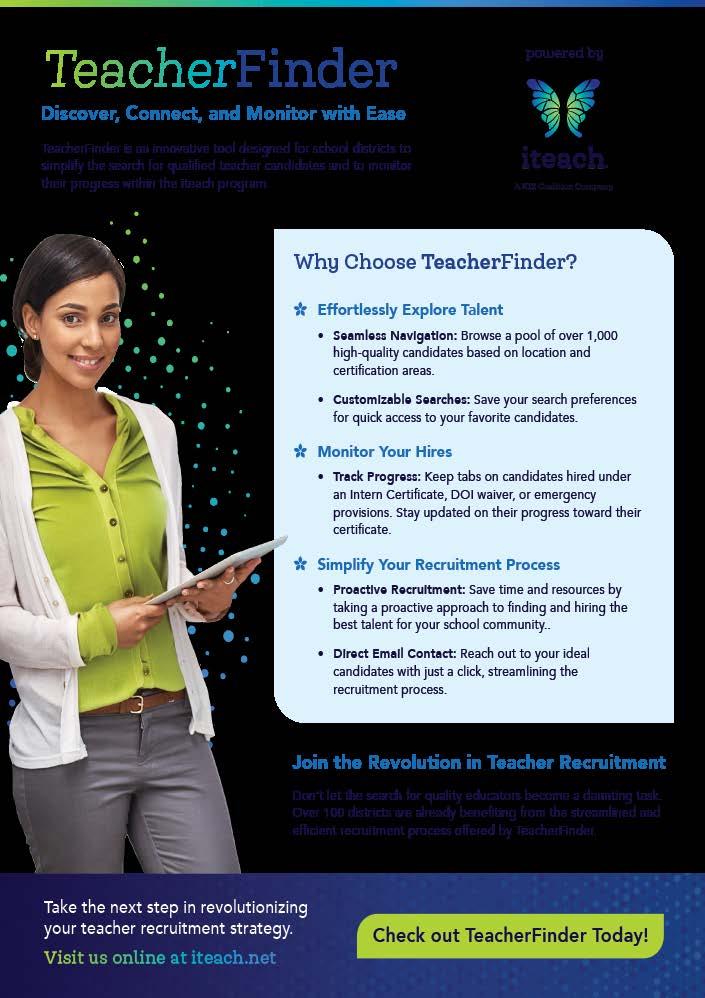
7 minute read
Driving Continuous Improvement through Strategic Planning and Alignment in HR
Eddie Curran Chief Human Resource Officer
Round Rock ISD
Anyone who has worked in a school district HR department knows how many transactional processes are involved in supporting employees daily. All good systems run on well-developed and consistent processes, and the best HR departments run on well-designed Standard Operating Procedures, handbooks, and guidelines. As much of our work relates to compliance with federal, state, and district law and policy, transactional work and processes can easily dominate our and our employees’ daily tasks.
Round Rock ISD is a large suburban school district just north of Austin. We serve approximately 47,000 students across 56 schools, including 7 high schools, 11 middle schools, and 35 elementary schools. We are a district of over
6,300 employees and hire about 1,300 employees annually. We are also proud to be the home of the 2025 Texas Secondary Teacher of the Year!
I joined the district as the Chief Human Resources Officer in the fall of 2021. Before starting, I had some idea that the work the district HR department was facing, was similar to that in other school districts across the state. We were all in the middle of the pandemic, writing and rewriting COVID protocols, providing guidance to principals on how to address employees regarding masks, and trying to staff in-person and virtual learning programs. The Round Rock ISD HR Team also supported typical transactional processes, including general staffing & recruitment issues, compensation, personnel records, performance management, training and development, and leave and benefits to name but a few. I was fortunate to inherit an experienced and hard-working staff with much expertise in HR processes. What was not clear at the time was the department’s readiness to approach post-pandemic challenges around staffing and ensuring we were supporting our employees as needs evolved.
So what were these challenges? We had an overall increasing teacher and staff turnover, with fewer applicants for vacant positions. We also were experiencing rising health insurance costs, increasing staff absences and lower substitute fill rates, general inflationary pressures in terms of cost-ofliving as well as overall district budgetary pressures. In addition to these general challenges, the department lacked systems and relied on expertise and experience rather than documented processes. Indeed, knowledge was siloed according to job function, with little shared understanding and collaboration opportunities within the department. Mining data to look for trends and progress monitor required a lot of time and effort. Lastly, there was a lack of available ongoing feedback from teachers and staff, one example of which led to a lack of awareness of potential turnover/retention issues, with awareness only becoming apparent when the end-of-year climate survey or employee exit survey results became available.
In 2021-22, the district also had a new superintendent and experienced turnover in key positions at the district leadership level, meaning that district priorities were about to change! I knew we would have to modernize, become agile, and be responsive to those new challenges. Knowing that and with so much of our time devoted to completing transactional tasks, how would we find the time to think and act strategically to address these challenges? Moreover, how could we ensure that the HR department functional teams were aligned and empowered to support current and future work? The reality was, that the HR staff was in “survival” mode, spending much of their time addressing employee issues, errors, and requests. Additionally, the existing district strategic plan was almost 10 years old, and while an employee-focused performance objective had been established in that plan, no specific action items, strategies, or timelines had been created that were associated with that objective.
It became quickly evident that we would need to rethink the work in HR if we were going to be able to meet the challenges. We quickly established a simple, common mission for the department to rally around. We shared with staff that the purpose of our HR department was to put systems in place to ensure that every student had a quality educator in front of them every day. Having that single focus immediately allowed us to align our efforts around a single purpose. We knew the importance of having a meaningful mission, and that connecting our work to the students themselves connected our work to the larger purpose of the district. Once the mission was established and articulated came the organization of duties - did we have our resources in the right places to help us ensure the success of our mission? Lastly, it was evident that department goals should be developed. Our HR team needed clarity on where the areas of focus were for the department, and goals that were aligned with the district performance objective would support that: We knew we had to create alignment to the objective and goals; we referenced them often and connected them to concepts within HR trainings, staff and leadership meetings, even when presenting to the School Board.
Everyone needed to understand our purpose!
On reflection, our initial efforts were reactive to the immediate challenges, since quick action was needed in most respects to help us move the district forward. Some examples of these efforts were that we developed an educational assistant-to-teacher pipeline, launched a program that allowed teachers to be paid extra duty pay when covering for absences when substitutes weren’t available, implemented retention and longevity incentives, and launched a listening tour that provided us feedback from teachers directly. Adding extra programs within the department came with some unintended outcomes; there was an increase in staff turnover as areas of responsibility changed, workloads increased and department goals and areas of focus changed. Moreover, the creation of new programs on a short timeline did not allow for much engagement and input from other stakeholders. This meant that while all of these programs were well-intentioned, they landed as an HR solution rather than a district solution - in some cases, they did not survive beyond the first year.
The following year, we started to rethink our approach to change. With virtual learning being in the rearview mirror and the district stabilizing after the pandemic, we were able to devote more time to department goal-setting and perhaps more importantly, connecting those goals with the overall district goals. We intentionally dedicated time and energy to sharing and synthesizing these goals within the HR department, as well as with stakeholders outside of the department. This ensured that there were stronger connections with our work across the district, we enjoyed greater advocacy for those goals outside of our department, and we created an environment where those goals became larger than just those of HR but were shared across the district. We openly talked with principals about their role in recruiting and retaining staff at their campuses for example, and encouraged them to develop campus-specific recruiting approaches. Several of the programs that were implemented the previous year were refined, and aligned with the new goals, while those that were not were discontinued.
Creating shared goals and communicating those often within the department fostered greater cohesiveness and also allowed our HR functional teams to begin working together on shared programs that were responsive to those goals. Over time, this intentional collaboration moved these teams out of siloes and created cross-functionality that allowed for system and process improvements within the department also. This meant that our transactional work became more efficient, thus creating more time for strategic work! Teams shared perspectives and learned more about other functions within the department, which in turn empowered staff with knowledge and new skills which in some cases led to them advancing within the department.
By 2023-24, the HR department looked very different from how it did two years prior. We had taken the goals from the year prior, developed a department improvement plan with specific action items and associated strategies, developed progress monitoring tools, and expanded the leadership capacity within HR by creating extended leadership training opportunities focused on project management and leadership development. Department teams owned the goals and strategies within their functions, had responsibility for progress monitoring, and shared their progress towards attaining their goals through staff meetings and huddles. We created an HR dashboard, which showcased our metrics and KPIs, and those became a point of pride for teams as they shared their work with others. As new programs from the previous two years matured, they were supplemented by new initiatives that were tied to the goals, while the focus on streamlining and creating efficiencies helped create space for staff to spend more time on strategic work. Staff turnover, which had peaked during the first year, had significantly reduced and staff culture and morale increased as employees became more engaged in the direction of the department.
In the last three years, the Round Rock ISD HR department has morphed into a goal-oriented team driven by data, performance metrics, and reporting. Our staff know and understand the data and can speak to their personal growth goals, how those impact the department goals, and how those goals support the strategic plan of the district. We still work hard, but there is greater alignment between teams, a shared understanding of the purpose, and opportunities for collaboration between teams, with improved results and a greater likelihood that new programs will be sustained over time.
So how do you drive continuous improvement through strategic planning and alignment in HR? A few key takeaways:
1. Focus on your mission and make sure your team is aligned and focused on the same mission!
2. Identify your priorities according to that mission and make sure that your resources (people, funding, and technologies) are aligned with those priorities.
3. Develop department goals that will help you achieve the mission, and share those goals with all.
4. Align the work your teams are currently completing with the goals - this helps combat feelings of being overwhelmed that often arise when new programs are launched, while also creating alignment, focus, and the sense that individual work is contributing to the overall purpose of the department.
5. Build data and reporting tools - to progress monitor you need metrics and KPIs. Those metrics should be reviewed, monitored, and celebrated at all levels within the department and shared with those outside of HR.
6. Look for intentional ways to build capacity in your staff - you can’t do the work alone.
7. Constantly identify opportunities to streamline and create efficiencies in workflow and processes to free up time to think big.
8. Share and celebrate your story and your wins!









